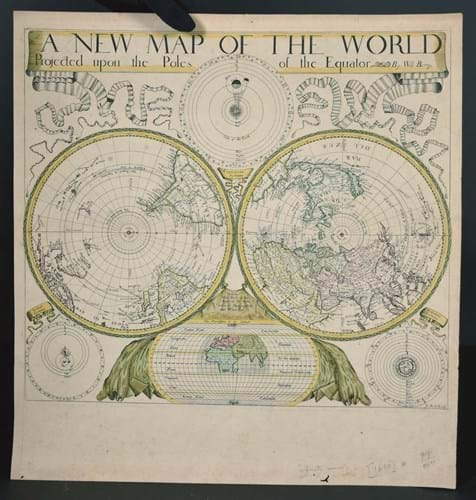
John Speed was one. William Berry was another. The son of a Warwickshire baker, Berry’s publishing business based ‘at Ye Sign of the Globe between Charing-Cross and White-Hall’ was active from c.1670-1703.
For a time at least he was in partnership with Robert Morden (c.1650-1703). The pair’s 1673 New Map of English Plantations is considered the first general map of the American colonies.
In 1677 Berry and Morden petitioned for “a licence to do all general and particular maps of the several parts of the world according to an alphabetical manner and method first projected by them against any other undertakers”.
It seems the project was not fulfilled but Berry did rework a series of double-hemisphere maps of the world by Frenchman Nicolas Sanson (1600-67) which were issued between 1680-89. He advertised them in the Term Catalogues and the London Gazette. They were available either as separate sheets or to be ‘bound in books or pasted on cloath at reasonable rates’. Thomas Chubb, in his Printed Maps in the Atlases of Great Britain and Ireland, 1579-1870, describes this rare collection as “the English Sanson”.
The most commonly encountered map from the series is the Mapp of all the World.
Berry’s cartographic amendments amounted to small patriotic revisions. Alongside a dedication to Charles II, he added the islands discovered by Francis Drake just off Tierra del Fuego and New Albion in the northern part of California (shown here as an island).
However, a rarer survivor – and one that perhaps sold in smaller numbers at the time – is the 17 x 18½in (43 x 47cm) sheet titled A New Map of the World Projected upon the Poles of the Equator. Engraved for Berry by John Rich, it includes both the twin projections plus ancillary planetary diagrams titled Copernican Systeme, Tychoes Systeme and Ptolomies Systeme along with adiagram of global temperature zones titled The Planisphere of the Antients.
An online search finds just two other copies – in the collection of the Library of Congress and the British Library – so it was a surprise to see another surface at John Nicholson’s auction in Haslemere on December 22. Seemingly in fine condition, trimmed to the margins and the top with hand colouring to the continental boundaries, it was estimated at £200-300 but took £7500 (plus 25% buyer’s premium) from an overseas buyer.














